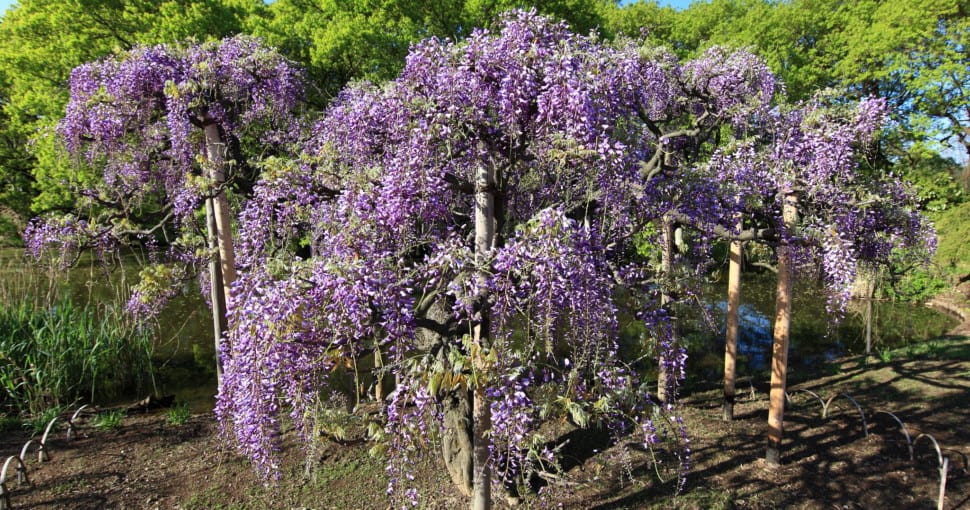Wisteria is gorgeous, like a bride draped for a purple wedding day. Despite appearances, Wisteria is not a tree but a woody vine that can be trained to resemble trees. There are 8-10 species, and they are related to legumes, such as peas, in the Fabaceae family. But for those that enjoy variety, there are other plants that have a wisteria flair.
Contents
The tree most similar to Wisteria is the South American Jacaranda that flourishes in South Africa and Australia. Other excellent alternatives include:
- Tree Wisteria
- Empress Tree
- Texas Mountain Laurel
- Chilean Potato Tree
- Trumpet Tree
- Royal Poinciana
Wisteria is beautiful, but it is not perfect. Wisteria is poisonous, including to dogs and cats. The tree-like-vine is also considered an invasive species in certain places, especially the Chinese wisteria. It can also put a lot of stress on a wall or fence. Thus, it can sometimes be best to look at alternatives, such as the following seven trees.
1. Jacaranda: The Most Wisteria-Lookalike
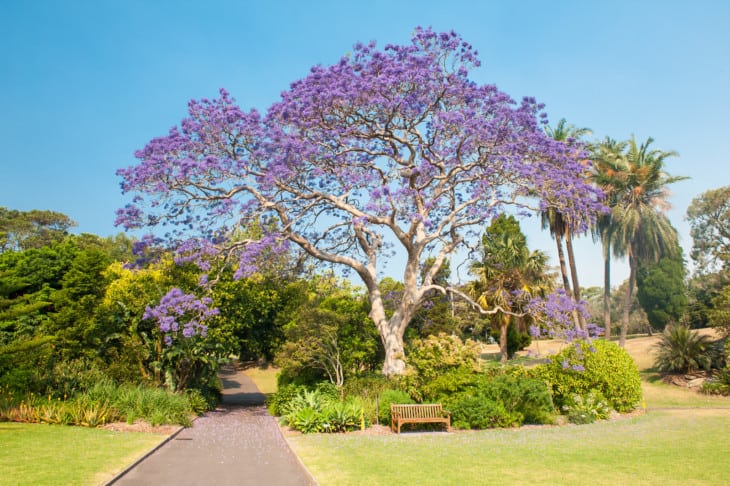
Jacaranda is a taller, more robust, wisteria lookalike. It is famous in the South African city Pretoria, nicknamed Jacaranda City. Just take care not to walk across the blossoms in your bare feet as there are often bees lurking in there. Jacaranda is also hugely popular in Australia but is native to South America.
Jacaranda thrives in sub-tropical climates. They can tolerate brief periods of chill, down to 15 F (-9 C), but they don’t like it, and long spells of frost can stunt growth. Jacaranda does best in full sun, well-draining sandy soil, and protection from cool winds. Thus, they do well in US states like Texas and California, so long as not on the coast.
Jacaranda grows at a pretty decent pace, reaching around 60 feet (18 m) with a similar length in breadth. So they need to be planted away from anything else to allow the canopy to reach full potential. Like a wisteria, its lavender flowers drape but in shorter bunches, similar to grapes. These trees do require regular pruning.
2. Tree Wisteria: The Faux-Wisteria
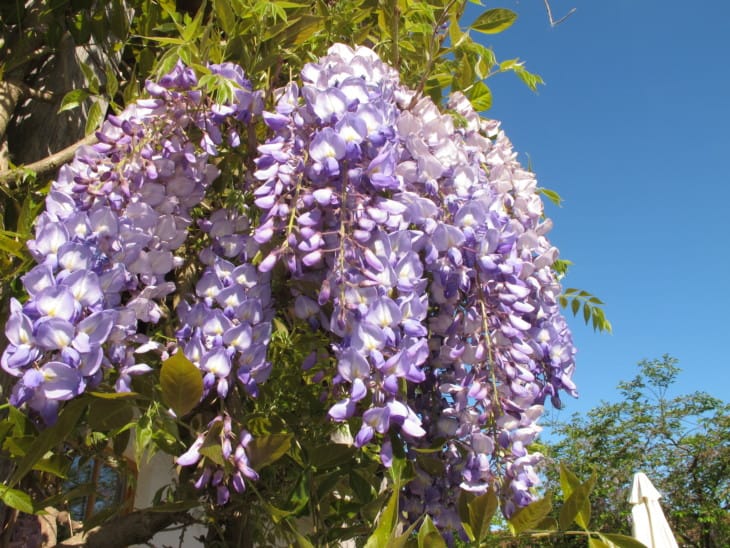
Unlike the jacaranda, tree wisteria is native to South Africa, although considered invasive outside of its original zone in the country. It is often mistaken for a short jacaranda and is incredibly drought resistant after a few years of growth. While it is also in the Fabaceae family, it is part of the Bolusanthus species and is sometimes used in herbal remedies.
Tree wisteria is often grown from seed, and while its initial growth is slow, it eventually picks up the pace. The tree is a much more manageable size for smaller properties, reaching 13 – 22 feet (4 – 7 m). Although tree wisteria isn’t the bonsai variety of this South African plant, it can be shaped and kept smaller if desired to 6.5 – 16 feet (2 – 5 m).
Tree wisteria’s purple flowers can vary in hue, up to a dark blue-black grape, and drape in beautiful bunches. It also grows brown pea-like pods. However, the branches do not form the same extensive canopy of a jacaranda or how a true wisteria can be trained.
3. Empress Tree: The Faux-Chinese Wisteria
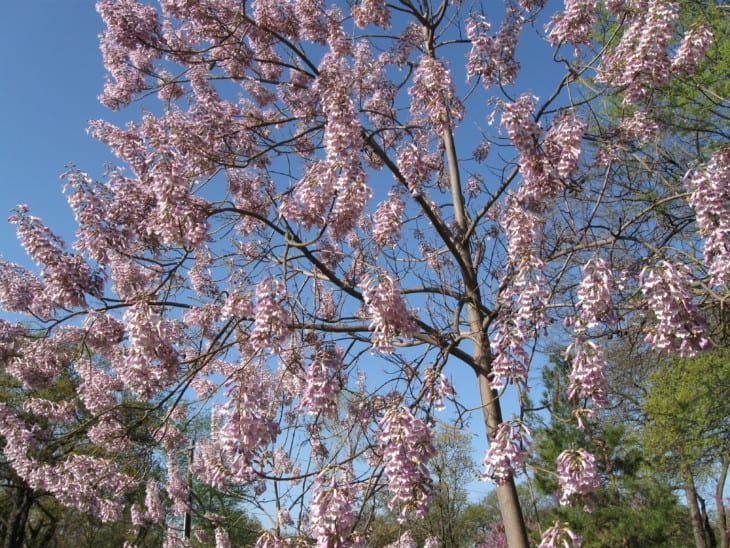
The Empress tree, paulownia tomentosa, is native to China. It also goes by the common names princess tree and foxglove tree. The empress tree is often mistaken for the real Chinese wisteria, wisteria sinensis, a woody vine that has become popular in North America, arriving in 1816.
The empress tree is a fast-growing invasive species in the United States. However, in some areas of the world, it is still welcome. New Zealand has even experimented with cultivating the hardwood in nurseries.
The empress tree produces pale purple foxglove-like flowers that cluster rather than drape. Its massive catalpa-like leaves lend the tree to being used as ground cover, by repeatedly cutting it back nearly to the soil. However, if left to grow, it will reach 40 – 65 feet (12-20 m).
4. Texas Mountain Laurel: The Tree-Shrub Wisteria
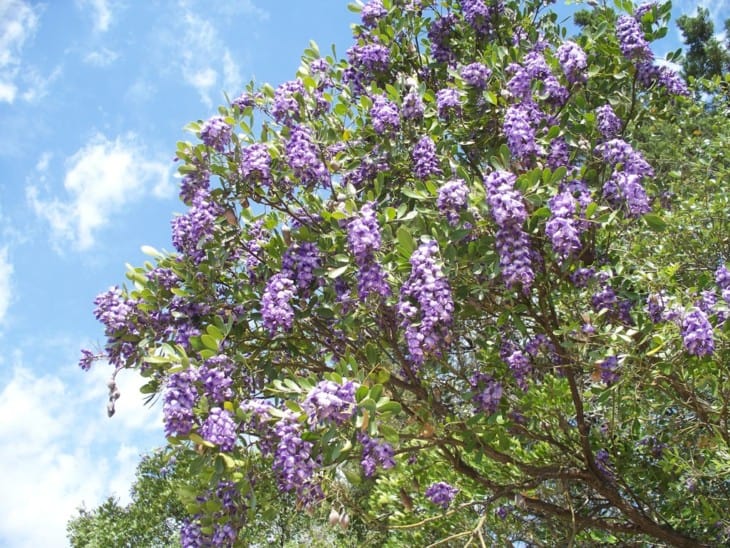
The Texas mountain laurel is a shrub that can be trained to appear as a small tree of 10 – 15 feet (3.6 – 4.5 m). Thus, the native Texas evergreen is perfect for people who love wisteria but have a modest amount of space. Like wisteria, its striking lavender blooms are poisonous. The flowers appear in heavy clusters rather than drapes.
The Texas mountain laurel is left alone by deer but attracts bees and butterflies. Most pests leave ignore it, aside from its nemesis, the genista moth. The genista larvae can devour the leaves of a bush in a handful of days.
5. Chilean Potato Tree: The Fruit Bearing Wisteria
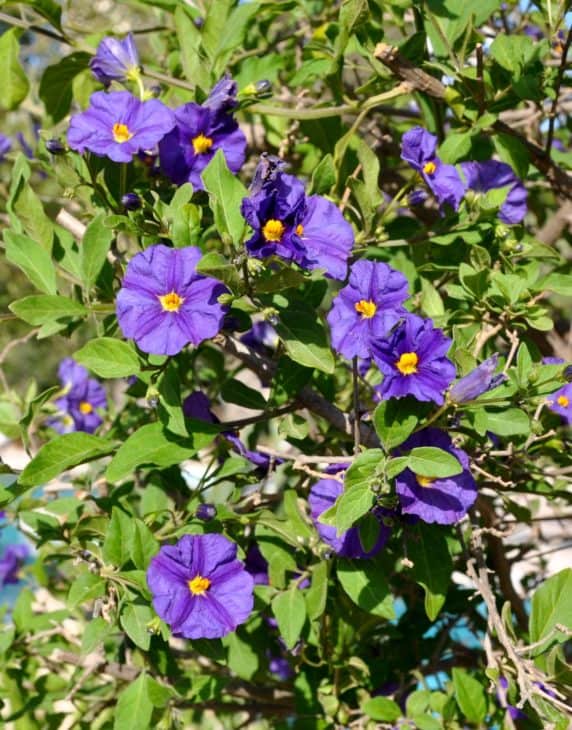
The Chilian potato tree is a climbing bush often tied to walls. As the name suggests, it is a relative to the potato. However, aside from making inedible yellow berries, as some potatoes also do, there is little obvious resemblance. Instead, it looks like a well-mannered wisteria when trained to spill over a wall.
The purple star-shaped flowers form in clusters and have a yellow center. They are deer resistant and can tolerate dry and hot areas. The Chilian potato tree will also thrive in a container, advised for gardens in colder climates.
It is a pretty fast grower, reaching 20 feet (6 m) and about 5 feet wide (1.5 m). The Chilian potato tree does well in full sun and well-drained soil. It needs a yearly hard prune near the end of spring.
6. Trumpet Tree: The Cherry Tree Wisteria
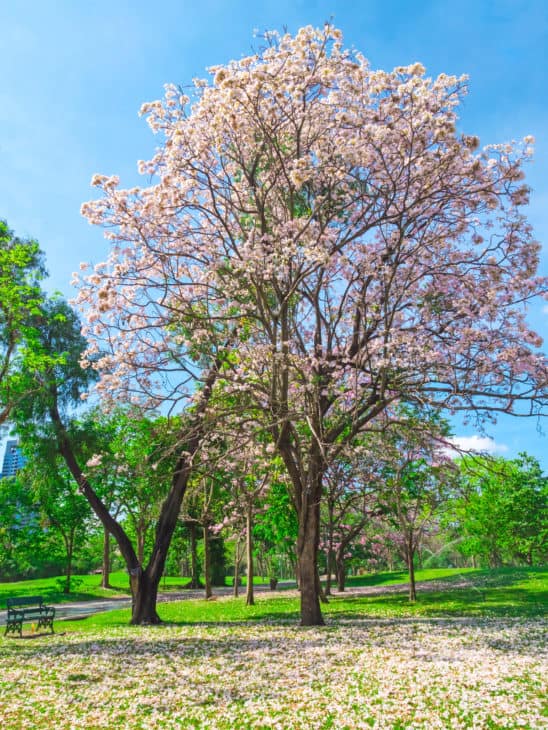
The trumpet tree is a South American plant that produces bell-shaped “trumpet” flowers in a few colors. The flowers reach 2-5 inches (5 – 13 cm) in length.
Popular Trumpet Tree varieties include:
- Tabebuia Caraiba (yellow flowers)
- Tabebuia Chrysotricha (yellow flowers)
- Tabebuia Heterophylla (pink flowers)
- Tabebuia Impetiginosa (white, pink, and purple flowers)
The pink trumpet tree is evergreen to semievergreen, depending on where it is planted. It resembles a cherry tree that has a wisteria grandparent. It can reach up to 30 – 50 feet (9 – 15 m) and widths of 30 – 40 feet (9 – 12 m). Its flowers grow in clusters and are 2-3 inches (5 – 7.5 cm). It enjoys full sun but can be grown in partial shade.
7. Royal Poinciana: The Red Wisteria
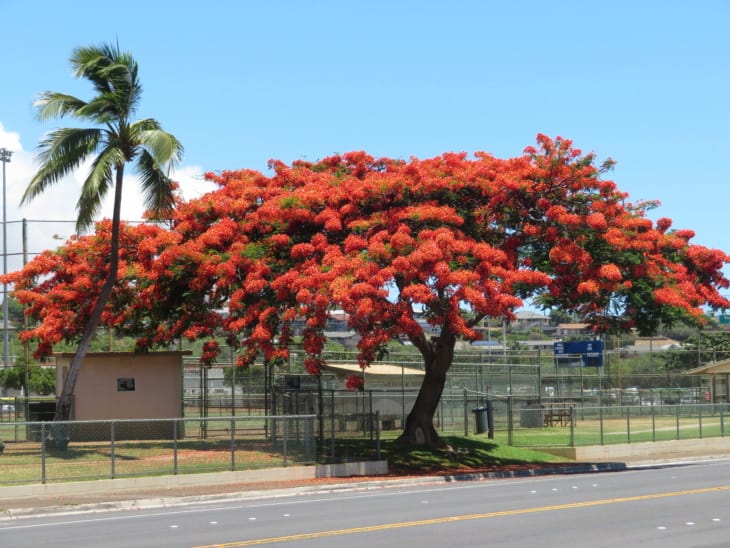
Thanks to its gorgeous tumbling red flowers, the royal poinciana is known as the flame tree. It has also been called the peacock tree. If wisteria were truly a tree and dyed its flowers red, it would be the Royal Poinciana. The two are related, as the royal poinciana is also part of the Fabaceae family and toxic to dogs and cats.
The royal poinciana originates in Madagascar and does not like frost. The subtropical tree loves full sun, thrives in humidity, and does best away from the coastline. It can reach up to 40 – 60 feet (12 – 18 m) and span a similar width. The royal poinciana may not flower for its first ten years of life.

